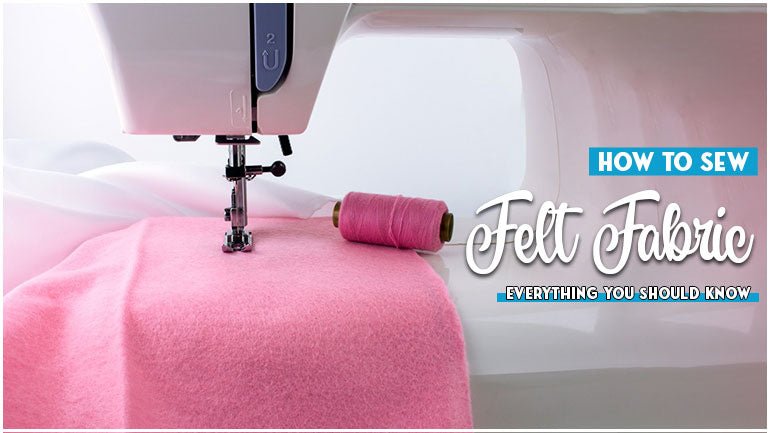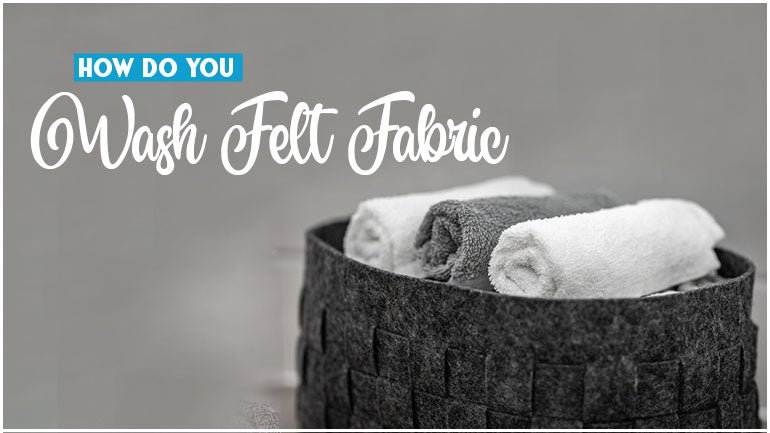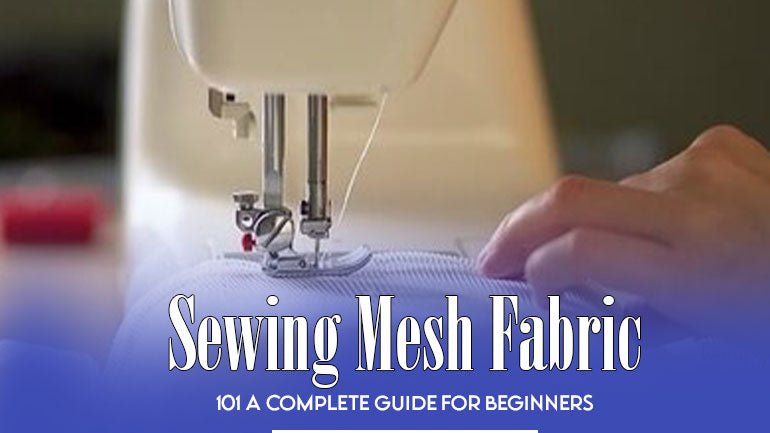Felt is an ideal material for sewing beginners and is easy to work with for crafts for children. Its wide range of colours and easy-to-sew construction make it an ideal choice for numerous DIY projects. You can make home decor, an original present, or even Christmas decorations.
Have you ever been wondering how to sew Felt Fabric? We will explain tips and tricks on sewing felt fabric. You can find a concise explanation of the concept of felt as a material and types.
Our guide outlines the needles and threads to choose to work with felt. There are hand-sewing techniques and machine sewing techniques for sewing felt.
Table of Content
- What is Felt Fabric
- Advantages of Felt Fabric
- What Stitch is Best for Felt?
- Thread for Sewing with Felt
- Thread for Sewing Felt with Sewing Machine
- How to Cut Out Felt
- How to Trace on Felt for Embroidery
- Can a Regular Sewing Machine Sew Felt?
- Faqs
What is Felt Fabric
Felt fabric is a type of textile material that is made by compressing and matting fibres together. It is produced through a process called felting, where wool or other animal fibres are subjected to heat, moisture, and pressure. The fibres interlock with each other, creating a dense and durable fabric.
Felt has been used for thousands of years and is one of the oldest known textiles. It has a wide range of applications due to its unique properties. Felt Fabric is known for being soft, strong, and highly insulating. It is also resistant to fraying and unravelling because the fibers are entangled and bound together.
Felt fabric comes in different thicknesses and colors, allowing for versatility in its applications. It can be made from different types of fibers, including wool, synthetic fibers like acrylic and polyester, or a blend of both. The choice of fiber affects the texture, appearance, and performance of the felt fabric.
Advantages of Felt Fabric
Here are some of the advantages of felt fabric:
- Soft and comfortable: Felt fabric has a soft and plush texture, making it comfortable to touch and handle. It feels cozy against the skin, making it suitable for clothing, accessories, and home decor.
- Durability: Felt fabric is highly durable and long-lasting. It is made by matting and pressing fibers together, resulting in a strong and sturdy material. Felt can withstand frequent handling, stretching, and bending without tearing or fraying, making it suitable for various crafts, upholstery, and industrial applications.
- Versatility: Felt fabric is incredibly versatile and can be used for a wide range of purposes. It comes in various thicknesses, colors, and finishes, allowing for diverse applications such as clothing, hats, bags, slippers, crafts, toys, decorative items, and even soundproofing.
- Absorbent and moisture-wicking: Felt fabric has natural absorbent properties, allowing it to soak up liquids and moisture. This makes it useful for applications like coasters, placemats, and pot holders. Additionally, felt can wick away moisture from the skin, keeping you dry and comfortable.
- Easy to work with: Felt is a forgiving fabric that is relatively easy to cut, sew, and shape. It doesn't fray easily, so there is no need for hemming or finishing edges. It also adheres well to other materials, making it suitable for crafts and DIY projects.
- Eco-friendly: Felt fabric can be made from natural fibers such as wool, which is a renewable and biodegradable material. This makes it a more sustainable choice compared to synthetic fabrics. Additionally, the production process of felt requires less energy and water compared to other textiles.
Discover More: Types and Uses of Felt Fabric.
What Stitch is Best for Felt?
The blanket stitch is known as the best stitch for working with felt. This stitch is ideal for securing the edges of felt fabric, as it provides a clean and neat finish while also offering strength and durability. The blanket stitch involves looping the thread around the edge of the fabric at regular intervals, creating a series of small, overlapping stitches. This technique not only prevents fraying but also adds a decorative touch to felt projects. However, the blanket stitch can be easily adjusted in size and tension, allowing for versatility in different felt applications.
Thread for Sewing with Felt
When it comes to choosing the right thread for sewing with felt, there are a few options to consider. The choice of thread depends on the project and the desired outcome. Here are three popular choices:
- Embroidery Floss: Embroidery floss is a versatile thread that comes in a wide range of colors. It is perfect for adding decorative stitches and intricate details to your felt projects. Embroidery floss consists of six strands that can be separated to achieve different thicknesses.
- Perle Cotton: Perle cotton is a mercerized cotton embroidery thread that is known for its softness and luster. It comes in different sizes and is often used for hand embroidery on felt. Unlike embroidery floss, perle cotton cannot be separated into individual strands.
- Polyester Sewing Thread: For functional stitches and reinforcement, polyester sewing thread is a reliable choice. It is strong and durable, making it suitable for sewing edges, buttons, and beads on toys made from felt. Polyester sewing thread is also commonly used with sewing machines.
Thread for Sewing Felt with Sewing Machine
When sewing felt with a machine, an all-purpose polyester or cotton thread is recommended. You can also use quilting thread, which is thicker and provides more visible stitches. The choice of thread depends on the thickness and composition of the felt:
- For wool felt or predominantly wool blends, it is best to use cotton sewing thread.
- For polyester, polyester-rich blends, and other synthetic felts, polyester thread is preferred.
Needle for Sewing with Felt
Choosing the right needle is crucial for a successful sewing project with felt. Here are the types of needles suitable for sewing felt:
Needle for Sewing Felt by Hand:
What is the best hand sewing needle for felt? When sewing felt by hand, embroidery needles (also called crewel needles) are commonly used. These needles have a sharp tip and a larger eye, allowing them to accommodate thicker threads like embroidery floss and perle cotton. Choose a needle size that matches the thickness of your thread and is comfortable for you to sew with. Smaller needles are preferred to minimize visible holes in the felt.
Needle for Sewing Felt with a Sewing Machine:
When sewing felt fabric with a sewing machine, it is recommended to use a medium-sized needle, such as a 70/10 or 80/12 universal machine needle. Thicker felt or multiple layers may require a 90/14 needle, but be cautious, as larger needles can leave visible holes. For most felt sewing projects, a medium-sized needle will suffice.
Enhance Your Knowledge: How to Make Felt Flower in Just 3 Steps
How to Cut Out Felt
Before you start sewing, you'll need to cut out your felt pieces. Here are some tips and tools for cutting felt:
Scissors
Use smaller sharp scissors with pointed ends, such as embroidery scissors, for cutting precise shapes and achieving neat edges on your felt. Invest in good-quality scissors, as felt tends to dull them. Consider using a dedicated pair of scissors solely for your felt projects to maintain their sharpness.
Rotary Cutter Quilter's Ruler, and Cutting Mat
For cutting straight lines, squares, and rectangles in felt, using a rotary cutter along with a non-slip quilter's ruler and cutting mat can provide accurate and efficient results. This combination is particularly useful for larger or repetitive cutting tasks, such as making pages for quiet books or puzzle base pieces.
Tracing and Cutting Machines
Electronic cutting machines like the Brother Scan-N-Cut and Cricut Maker offer precise cutting capabilities for felt and can save you time and effort. If you prefer a manual cutting machine, the Sizzix Big Shot Plus is a popular choice. It works well for cutting felt flower shapes and other die-cut designs.
How to Trace on Felt for Embroidery
Adding embroidery details to your felt projects can enhance their visual appeal. Here's how you can trace and embroider on felt:
Tracing on Felt
There are multiple methods for transferring embroidery designs or patterns to felt. One popular technique involves using tracing paper. Simply draw your design on the tracing paper and sew through it to transfer the design onto the felt. Other methods include using transfer pens, carbon paper, or iron-on transfer paper. Experiment with different methods to find the one that works best for your project.
Embroidering on Felt
When embroidering on felt, practice and precision are key. Use basic embroidery stitches like the running stitch, blanket stitch, whip stitch, straight stitch, backstitch, and French knot to sew your desired designs. These stitches are relatively easy to master and can add beautiful decorative elements to your felt creations. Remember to pay attention to stitch size, length, and consistency to achieve the desired results. If you're not satisfied with your stitching, don't hesitate to remove it and start over.
How to Sew Felt
Now that you have all the necessary tools and techniques let's explore how to sew felt fabric both by hand and with a sewing machine.
How to Sew Felt by Hand
Hand sewing with felt is perfect for small projects, such as stuffed animals, Christmas decorations, finger puppets, and more. The running stitch, blanket stitch, and whip stitch are commonly used for sewing felt by hand. The running stitch is a basic stitch used for joining felt pieces together, while the blanket stitch not only joins the edges but also adds a decorative touch. The whip stitch is ideal for finishing off the edges neatly. For decorative purposes, you can experiment with the straight stitch, backstitch, and French knot. Practice these stitches to create stunning embroidered designs on your felt projects.
How to Sew Felt with Sewing Machine
If you use a sewing machine to sew felt, begin by selecting the appropriate needle and thread, as mentioned earlier. Test the tension and stitch size on a scrap piece of felt to ensure the desired results. A straight stitch is the most commonly used stitch for sewing felt with a sewing machine. Depending on your machine, you may also have a blanket stitch option, which can give your felt project a handmade look. Ensure that you use the standard sewing foot for most felt projects, and if you're working with thinner craft felt, consider doubling the fabric or using a backing fabric for added stability.
Read More About: The Ultimate Guide to Drying Felt Fabric
Can a Regular Sewing Machine Sew Felt?
Yes, a regular sewing machine can sew felt. Felt is a versatile fabric made from compressed fibers, and it can be easily sewn using a standard sewing machine. To ensure a smooth sewing experience, it is recommended to use a universal or ballpoint needle specifically designed for sewing through fabrics like felt.
Faqs
Should I wash felt before sewing it?
It is not necessary to wash felt fabric before sewing it, as felt is a non-woven fabric that does not generally shrink or fray.
How do you sew felt seams?
If you are intended to sew felt seams, use a whipstitch or running stitch along the edges, ensuring the needle passes through both layers of felt to create a secure and neat seam.
Does felt have a right and wrong side?
Felt typically does not have a right or wrong side as both sides are similar in appearance and texture, allowing you to use either side for your project without any noticeable difference.
What happens when felt fabric gets wet?
When the felt fabric gets wet, it generally retains its shape and colors well. However, it may become slightly distorted or shrink if exposed to excessive moisture or heat. It is advisable to allow wet felt to air dry thoroughly to prevent any potential damage.



